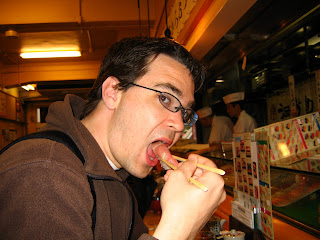though Jill is not a huge fan of Japanese food, even she agreed that we had to try Nagoya's specialty gastronomic treat at least once. we finally did this on the eve of our departure for Europe, which also just happened to be our friend Kevin's birthday. his wife, Misty, had selected a very swanky restaurant which handily specializes not only in kishimen noodles but in shabu-shabu as well, which we had been recommending to them for months. shabu-shabu is a Japanese version of hot-pot, with vegetables and thinly sliced meats served raw so the diner can dip them briefly in a boiling broth to cook. supposedly, the proper cooking time is achieved as you hold the meat with your chopsticks and swish it through the water twice while saying "shabu, shabu". most likely an urban legend though, since even i like it done a little longer than that.

the luxuriant settings of our traditional Japanese meal, showing the sometimes scary food and our often scary methods of eating it, and our ultra-attentive and traditionally kimonoed server whom i'll call Chiyo-chan.
the place we went was very elegant, with traditional low table and tatami mat floor seating, all in our own private room with sliding screens for entry. we had this serving girl who kind of looked like the the young Chiyo character in the film Memoirs of a Geisha, and i felt badly that she always had to kneel down to slide open the door before shuffling through and kneeling to close it again, much as is depicted in the movie. this is very traditional too, and would constitute a great luxury--had we been fully able to appreciate it, anyway. she spoke very little English and we even less Japanese, and she seemed very embarrassed by us and quite flustered much of the time, but she did a wonderful job of demonstrating the correct protocols for us. the whole meal was very ritualized in many ways, and it certainly took a long time.
towards the end of it she brought in the kishimen, which are large, flat wheat-based noodles, a bit like chunky and chewy fettuccine. honestly they were mot much different from other udon-type noodles, but people seriously come from far and wide to try Nagoya's special dish in Nagoya. following the noodle service we suddenly became aware that our personal Chiyo-chan had served each of us some of the remaining broth from our hot pots, and was watching us intently to see how we would like it. i knew that i, for one, was not at all excited about sating her curiosity; this is water from which we had been scooping the frothy dregs of our cooking meat for the past two hours, and the others weren't looking too thrilled to try it either. but try it we did, for one does not wish to make their Japanese friends lose face. surprisingly, it was quite good and very tasty, though a little hard to finish on such full stomachs; perhaps more surprisingly still, nobody got sick from it afterwards.

Jill and Megumi bringing down the house with their version of Sukiyaki, while below, Kevin and Misty bring back up the classics with Hey Jude.

not surprising, however, was our after-dinner activity: karaoke. our friend Megumi joined us for this too-brief portion of the evening and punched out a couple of Japanese hits to get Misty and Kevin into the groove of their first experience. it was quite a time we had, and hopefully quite a birthday--so many firsts in one day. and the way they got into it, i'm sure it won't also be a day of lasts, as least for karaoke if not kishimen.

the luxuriant settings of our traditional Japanese meal, showing the sometimes scary food and our often scary methods of eating it, and our ultra-attentive and traditionally kimonoed server whom i'll call Chiyo-chan.
the place we went was very elegant, with traditional low table and tatami mat floor seating, all in our own private room with sliding screens for entry. we had this serving girl who kind of looked like the the young Chiyo character in the film Memoirs of a Geisha, and i felt badly that she always had to kneel down to slide open the door before shuffling through and kneeling to close it again, much as is depicted in the movie. this is very traditional too, and would constitute a great luxury--had we been fully able to appreciate it, anyway. she spoke very little English and we even less Japanese, and she seemed very embarrassed by us and quite flustered much of the time, but she did a wonderful job of demonstrating the correct protocols for us. the whole meal was very ritualized in many ways, and it certainly took a long time.
towards the end of it she brought in the kishimen, which are large, flat wheat-based noodles, a bit like chunky and chewy fettuccine. honestly they were mot much different from other udon-type noodles, but people seriously come from far and wide to try Nagoya's special dish in Nagoya. following the noodle service we suddenly became aware that our personal Chiyo-chan had served each of us some of the remaining broth from our hot pots, and was watching us intently to see how we would like it. i knew that i, for one, was not at all excited about sating her curiosity; this is water from which we had been scooping the frothy dregs of our cooking meat for the past two hours, and the others weren't looking too thrilled to try it either. but try it we did, for one does not wish to make their Japanese friends lose face. surprisingly, it was quite good and very tasty, though a little hard to finish on such full stomachs; perhaps more surprisingly still, nobody got sick from it afterwards.

Jill and Megumi bringing down the house with their version of Sukiyaki, while below, Kevin and Misty bring back up the classics with Hey Jude.

not surprising, however, was our after-dinner activity: karaoke. our friend Megumi joined us for this too-brief portion of the evening and punched out a couple of Japanese hits to get Misty and Kevin into the groove of their first experience. it was quite a time we had, and hopefully quite a birthday--so many firsts in one day. and the way they got into it, i'm sure it won't also be a day of lasts, as least for karaoke if not kishimen.























































































